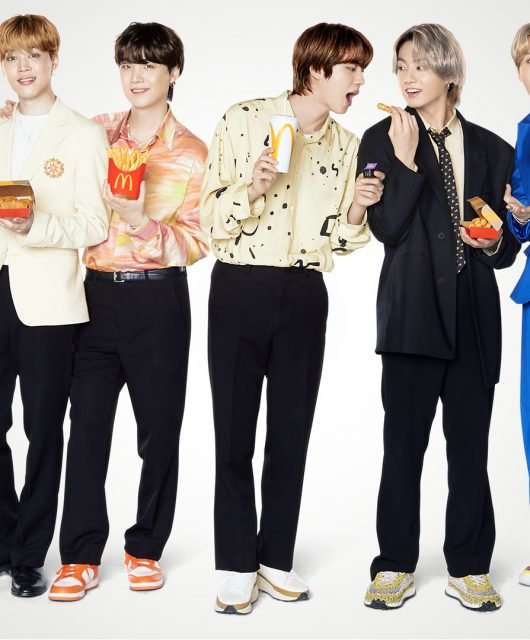Week: September 28Th – October 2nd
Several weeks ago, when the gravity of the situation became clear, Interbrand started regular reporting on how brands were dealing with the COVID-19 crisis. What’s now becoming clear is that the current climate is one of near perpetual disruption. So the brand consulting firm made the decision to keep on telling the stories of inspiring brand leadership and strategy amid the latest crises in an anxious world. Interbrand’s goal remains the same: to provide an up-to-the-minute source of information, inspiration and insight on brand moves as they happen.

Entertainment
As the streaming video market continues to thrive during lockdowns and the at-home entertainment boom, network Discovery plans to debut its direct-to-consumer streaming service — which will be called Discovery+, according to a trademark filing — in the first quarter of 2021.
The streaming service will have both an ad-free and an ad-supported option. Discovery is aiming the service at people who are less likely to tune in to Discovery’s linear networks, said agency executives. Discovery already operates separate streaming apps that require people to log in with their pay-TV subscriptions to stream its TV networks’ shows.
“This is for cord cutters,” said an agency executive. To attract cord cutters who are likely younger than Discovery’s linear audience, Discovery has been in the market for original programming, including reality shows and documentary series, for Discovery+ that appeal to younger adult audiences — twenty- and thirty-something viewers — and that star mainstream celebrities, according to entertainment industry executives.
Given Discovery’s ownership of networks including Discovery, TLC and Food Network, Discovery+ could vie to be the streaming network of choice for audiences interested in home, cooking and lifestyle-related programming as well as science-related documentaries. The service will be niche compared to general-interest entertainment services like Netflix, HBO Max or Peacock.
That could be to Discovery’s advantage, positioning it as a complement to other streamers that people may subscribe to. Such positioning has worked for Disney’s Disney+, which appeals primarily to families and has attracted 60.5 million subscribers since launching in November 2019.
Mobility
Ridehailing service Lyft has released a set of case studies for what it calls resilient streets, which cater to multimodal commuting, in which people rely on several different ways of getting around. The plans detail how streets in Chicago, New York City and Washington, DC could have wider sidewalks, plus more bus and bike lanes.
Some of the plans include details that would clearly benefit Lyft, such as adding more of its bikeshare stations and lanes for those bikes to ride in. (Lyft operates bikeshare systems in all three cities and scooters in Washington, DC.) Caroline Samponaro, who leads micromobility policy at Lyft, said that the company was motivated by steps cities have taken during the pandemic to embrace car alternatives, as well as by concerns that cities will revert to their car-centric ways.
Many cities have temporarily closed streets or added bike lanes and outdoor dining spaces. “We’ve spent the last couple decades trying to dig ourselves out of the mess of building our transportation systems around single occupancy vehicles,” Samponaro said. “We don’t want overnight for us to go backwards there.”
Samponaro pointed to people in some cases gravitating to cars amid concerns about transit and social distancing. Used car sales have grown this year. She said the design of streets signal to people how they should get around, and what options they have.
With more transit, bike and walking infrastructure, people are less likely to rely on cars. Samponaro declined to say if the plans would have any adverse impact on Lyft’s core business, and said that streets are currently an underutilized resource with little done to make them sustainable or efficient. Lyft wants to make cities more effective and efficient, she said.
Fashion & Luxury
Patagonia is placing tags in its latest line of women’s and men’s shorts, reading “Vote the assholes out” in block lettering. It has been a catchphrase of Patagonia founder Yvon Chouinard for years, according to the company, and speaks of politicians from any party who deny or disregard the climate crisis.
Chouinard founded the 1% for the Planet community in 2002, which commits one percent of Patagonia’s annual sales to the environment. “We have been standing up to climate deniers for almost as long as we’ve been making those shorts,” said the company in a statement. The shorts are regenerative organic certified, which meet standards for animal welfare, farmworker fairness and soil health.
“Remember, vote the assholes out – all of those politicians who don’t believe we should do anything about climate change,” wrote Chouinard in a blog post for the 1% for the Planet community at the start of the pandemic. “Vote for the planet and against those who would do nothing. We have the power and now is the time to use it.”
Beyond the shorts, Patagonia has a number of ways it’s working to get people to the polls. Patagonia is one of the founding members, along with PayPal and Levi Strauss, of Time to Vote, a nonpartisan coalition that aims to remove barriers to voting by having companies pay their employees to go to the polls. Time to Vote now has 882 members, with more than 700 companies signing up this past year, including Ben & Jerry’s, Bank of America, Nike, Macy’s, Lego, Unilever and others.
Travel & Tourism
Travel company Tui said it began 2020 with “the best booking month in the company’s history”. But the coronavirus crisis wiped out its operations for three months from mid-March. Between the restart of operations in mid-June and the end of August 2020, the company took 1.4 million people on holiday – filling five out of six seats on its planes on average.
But over the same spell in 2019, Tui provided holidays for around eight times as many people. The firm has said it expects late bookings to be the norm “until customers are able to plan with more certainty”.
The firm has cut its reduced summer 2020 offering still further by one-sixth, from 30 per cent to 25 per cent, and switched “to alternative low-risk destinations, enabling many customers to continue their holidays as planned”. With infection rates and government restrictions rising, the already reduced winter programme has been cut by a quarter.
Tui will now offer 60 per cent of its original programme, down from 80 per cent. Next summer’s overall schedule is expected to be 20 per cent lower, but Tui said average selling prices for summer 2021 are 10 per cent higher. It has restarted cruising on very limited itineraries, primarily in the Baltic, “with a mandatory negative PCR test result a prerequisite for travel”.
The chief executive of Tui Group, Friedrich Joussen, concluded: “Leisure holidays remain important to customers and have been one of the most missed activities during the pandemic. We are strategically well placed to benefit as leisure travel volume recovers over the coming seasons.”
United Airlines is turning to a Google-powered interactive map to help still-scarce travelers find destinations that fit the coronavirus era. The map, on United’s website, allows travelers to punch in the most they want to spend on a ticket and filter airports by their destination activities or descriptions: beaches, beer and breweries, culture, food and drink, hiking, national parks, outdoors, romantic, skiing and snowboarding, and snorkeling and scuba.
Air travel demand is stuck at less than a third of the same levels a year ago and airlines are scrambling to come up with ways to encourage travelers to book.
Executives have noted that travelers are waiting much longer to book than last year, a result of so much uncertainty surrounding the virus as well as work, school and child care. United’s new booking tool, which uses Google’s flight search engine, also allows travelers to browse flights without set dates.
“Where in the past, more people would look for flights to specific destinations on specific dates, we’re seeing that today, travelers are often more open about the destinations that they would like to visit,” United spokeswoman Christine Salamone said. “They know they’d like to get away, but they’re not exactly sure where they want to go.” United executives and those at other airlines have said they’ve seen relatively good demand for destinations that allow travelers to physically distance, such as those near national parks and others that offer outdoor activities.
Restaurants
Coffee chain Dunkin’ and hospitality stands at sports stadiums are testing a new checkout-free payment system from Mastercard as retailers try to meet shoppers’ desire for speed and reduced human contact. Their initiatives are similar to Amazon’s Go technology, which uses scanners, cameras and software to let shoppers walk out of a store without stopping to pay for their purchases.
Amazon has opened more than two-dozen Go-branded stores since 2018 and offered other retailers access to the technology in March. Early customers include OTG Experience at its CIBO Express stores in Newark Liberty International and LaGuardia airports.
Now similar experiments are spreading as companies double down on plans to reduce social contact in stores. A survey published by McKinsey & Co. in July found that most consumers in the U.S. and China who changed their shopping habits during the pandemic expect the change to stick after the crisis.
“We’re seeing huge growth in this market,” said Catherine Shuttleworth, founder and chief executive of retail consulting firm Get Savvy Marketing. “In a time where speed is really important to retailers, cashierless systems are going to be critically wanted pieces of technology.” Dunkin’ Brands Group Inc. is testing Mastercard’s system at an undisclosed store in California that will be rebranded as Dunkin’ Dash. Customers will have to register their credit card at a kiosk outside to receive a QR code that lets them enter. Cameras inside will track them as they select individually packaged baked goods, self-pour coffee and snacks.
Chinese consumers are finally starting to spend again after the pandemic-induced slump, but the recovery is unbalanced and overly reliant on luxury goods, with poorer Chinese still cautious. Consumption has started to catch up to the much stronger rebound in industrial output, with retail sales growing in August for the first time this year. Spending on luxury goods, cars and electronics is leading the charge, rising faster than food, clothing and other essentials.
Though the virus is under control, income and job losses due to the pandemic have made poorer Chinese unwilling or unable to increase spending, keeping a lid on the rebound. “Higher-income households have probably built up savings, because of the forced reduction in consumption during lockdown, and could now be ready for a spending spree. It is lower-income households that face a longer slog of normalizing their finances,”
He Wei, an analyst at Gavekal Dragonomics, said in a recent report. Luxury spending in China will grow 20%-30% this year, according to a report from Boston Consulting Group, but much of that growth is going to come from consumers in the 50 largest and richest cities. People in the other 2,206 cities bought only a quarter of all luxury goods in April-July this year, and their spending was down 4% compared with 2019, according to the report.
“The Mainland China retail market showed strong recovery over recent months, as driven by some pent up demand,” a spokesperson of Chow Tai Fook Jewellery Group said. It organized more than 230 livestreaming events between February and August to attract the young Chinese buyers. But it’s hard to say if this demand rebound can sustain. While Chinese consumers remain more confident about the future spending than most major Asian markets, 75% of Chinese respondents are still planning to cut back their expenses in the next 3 to 6 months amid the economic uncertainties triggered by Covid-19, according to a Nielsen report in September.
“When people can’t travel, they’ll spend money in other ways,” Justin Sargent, Shanghai-based president of Nielsen Asia, Retail Intelligence, said in an interview last week. “Generally speaking, the growth in recent months was driven by emotional spending. Going forward, we’ll see more rationality.”
To read the full report, please download here.
To access daily Brand Moves, please visit www.brandchannel.com.





